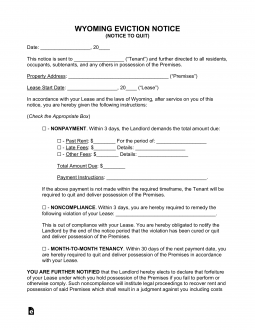Updated April 12, 2024
A Wyoming eviction notice is submitted by a landlord to a tenant who has violated the terms and conditions of a lease. The notice will include the offense and instructions on how the tenant can return to compliance with their agreement. If the tenant rejects communication, the landlord can file a Forcible Entry and Detainer lawsuit at the Circuit Court.
By Type (2)
 3-Day Notice to Quit (Non-Payment & Non-Compliance)– This form starts the eviction process when a tenant fails to abide by the terms of the lease. The landlord must wait three days before filing any proceeding in court. 3-Day Notice to Quit (Non-Payment & Non-Compliance)– This form starts the eviction process when a tenant fails to abide by the terms of the lease. The landlord must wait three days before filing any proceeding in court.
Download: PDF |
 30-Day Notice to Quit (Month-to-Month Tenancy) – This form lets a party to a month-to-month tenancy know that they do not intend to renew the lease at the end of the month. 30-Day Notice to Quit (Month-to-Month Tenancy) – This form lets a party to a month-to-month tenancy know that they do not intend to renew the lease at the end of the month.
Download: PDF, MS Word, OpenDocument |
Table of Contents |
Prohibited Landlord Acts
Utility Shutoff – Under state law, landlords must maintain electrical systems, plumbing, heating, and hot and cold water.[3]
Changing the Locks – The state of Wyoming has no statutes dictating whether a landlord can block a tenant’s access to the premises in the case of unpaid rent or a lease breach.
Court Forms
Complaint – Used by landlords to file a forcible entry and detainer lawsuit with the circuit court. If the landlord wins the lawsuit, the tenant will be legally evicted from the premises.
Summons – Served on a tenant to inform them that their landlord has filed an eviction complaint against them. The summons will indicate a trial date upon which they must appear to defend themselves.
Answer to Complaint – Tenants may use this document to indicate whether they agree with or deny the landlord’s allegations. If the tenant wishes to use the form, they must submit it to both the landlord and the circuit court before the trial date.
Writ of Restitution – Gives the sheriff’s office permission to remove a tenant from a rental unit after they’ve been evicted.
How to Evict a Tenant (4 steps)
2. File Complaint and Summons
The next step in the eviction process, assuming the tenant hasn’t responded satisfactorily to step one, is to file a Complaint and Summons for a Writ of Restitution with the Local Circuit Court in the county in which the property is located.
Filing fees vary by county:
3. Serve Tenant
The court will issue a summons to be served on the tenant by a process server which requires them to appear in court. The tenant can then file an Answer with the court.


